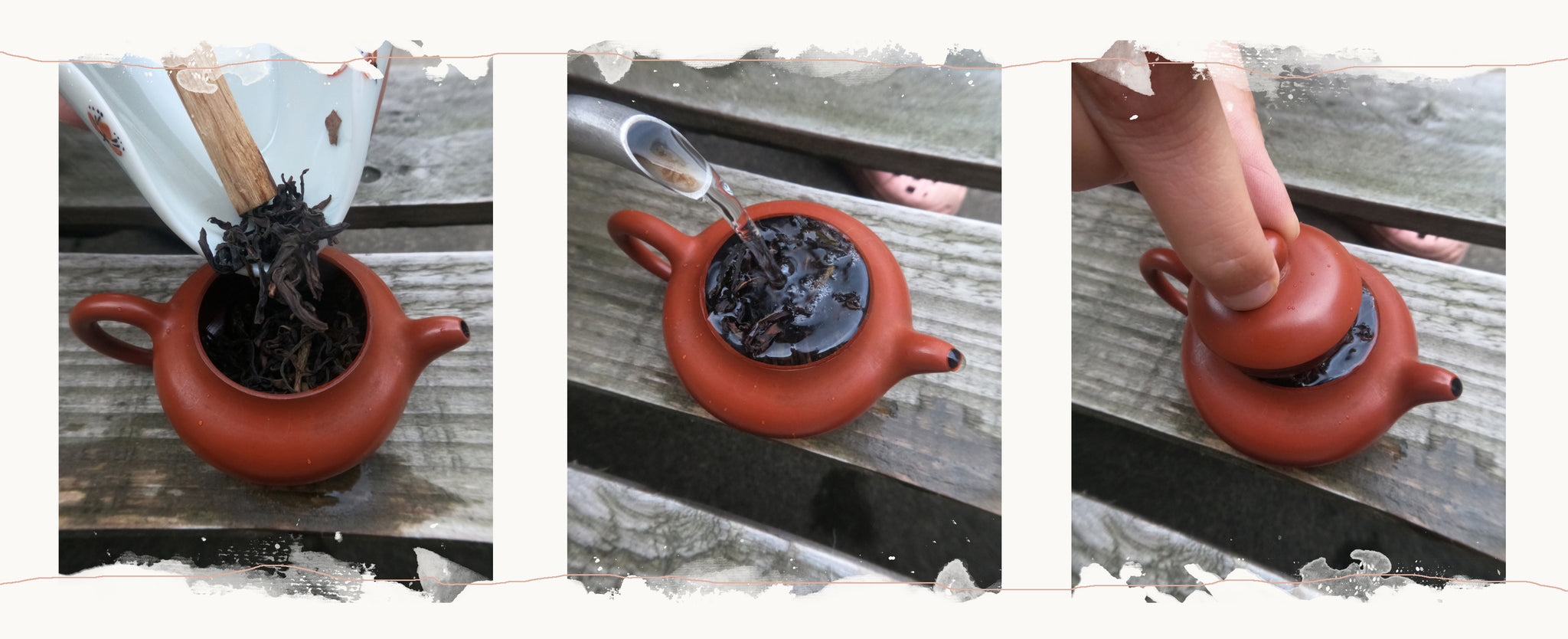It's autumn and as you may have noticed, we looooove to drink wulong teas.
Today, it seems the waterfall of cats and dogs pouring down the sky will never stops and so naturally our moods are little below the line of balanced happiness.
So we are in the need of tea and Dan Cong is the king of autumn (for us).

Origin
This tea comes from China, Guangdong province, Wu Dong mountain, Zhongshan village.
Dan Cong (meaning "Independent bush") teas are plucked from specific varieties of arbor style tea trees, many of which are more than 300 years old and reaching up to 5m height. Some of these trees have been pruned to a single trunk from which brunches appear, while others sprout right from the ground in style of bush. Wu Dong mountain is surrounded by plenty of rocks. Tea bushes grow in between these rocks.
Growing on the slopes of the Phoenix Mountain (Feng Huang) in red clay soil of altitude around 1200m these ancient tea trees are harvested only once a year. No fertilizer nor pesticide are being used on these unique trees.
The oldest tea tree available in Wu Dong Mountain is about 900 years old, these living legends are actually guarded 24/7 against poachers ... can you believe?
These old trees have very long, deep roots covering large surface area so they absorb much more minerals than younger trees. On top of that, old tea trees grow very slow, this slow process means, that the size of cells become very tiny and the tea leaf accumulate more organic substances that contribute to flavour and minerals. The presence of minerals is very essential to the quality of tea; it gives more depth in taste and enhance flavour.
There are few Dan Congs on the market such as Mi La Xiang (Honey orchid aroma), Qi La Xiang (Orchid aroma), Huang Zhi Xiang (Gardenia aroma) or Zhi La Xiang (Iris aroma), the modern cultivars used in these regions all descend from the original Dan Cong. Rich in aromatics their infusions are truly elevating.
How is Dan Cong made?
- Withering: After harvesting, the fresh tea leaves are brought back to the factory, and then spread to a thickness of about 10 cm on a bamboo mat. Then the tea is withered under sunshine until 5pm and then turned around to thinner spread in shade for another hour or so.
- Oxidation: Oxidation of D.C. is about 30-35%. Manually breaking the leaf cells to prepare for oxidating process. The atmospheric temperature required for oxidation to occur is around 22-28 degree C with a relative humidity of about 75-85% which starts in the evening about 6 – 7 p.m. and continues for approximately 10-12 hours until the following morning (in China,... ehm definitely not in Scotland :P)
- Heating & rolling: During the pan-frying process, a high temperature (140-160 C) and short duration of heating treatment (4-5min )will deactivate the enzymes instantly and prevents prolonged oxidation which would stabilize the quality and character of the oxidised tea leaves. While the tea leaves remain hot they are being rolled by hand. When the leaves have formed the primary shape, they go back to the wok for another round. The temperature is a little cooler about 100-120 degree C for another 3-4 minutes. Roast level: medium.
- Drying: The tea leaves are dried in a bamboo baskets that are heated using charcoal. First drying is 80-90 C for around 40 min where the moisture content of leaf is reduced by 30-40%. Second drying 50-60 C for around 20 min. The moisture of leaf is now around 5%.
Maturation
The mechanism that allows the Dan Cong wulong to develop its unique fruity flavour is very similar to the aging of Puer teas. As for the Puer tea, it takes many years to develop the fruity flavours. All these teas are better with age.

Taste & Brewing:
How did we brew our Dan Cong? In a tiny little Yixing teapot! The best choice for this tea as it enhance the earthy notes within the tea. We have used approx. 6g of dry leaves and as usual we washed them with boiling water before pouring 85 degree C water (filtered if possible). We waited for about 50 sec and poured the golden liquid out. You can see from our picture that the tea is very light as this was the first brew. We have stopped taking pictures with the next cups as we really want to enjoy the tea rather than record it :P (yeah we really like our time with tea so no interruptions!) :)
The Big, curly brown & yellow crunchy dry leaves seems kinda tough on the touch, but they do release beautiful aroma of well dried wood, dark cocoa and sweet caramel with a little mintiness.
The infused leaves turned to leathery brown & green colours, casually twisted. Aroma of wood, mint, geranium and ocean air (minerally) raising from the cup.

The cup is crystal clear. At start the cup has colour of light underipe apricots but with each brew the colour is turning into lovely deep amber. Aroma is sort of spicy, woody and herbally. Mouth-feel is crisp, wild and soft with notes of fresh green wood, orchids and apricots. After-taste carries mineral notes, honey and a little hint of lemon zest.
This tea has a little acidity & lively astringency.
For the second brew we have slightly raised the temperature to 87C and waited 1 min.
For the third brew we used 89C and brewed a minute and half.
Fourth and Fifth brews the water temperature increased to 92C and waited up to 2min... after this you can keep going but the tea is loosing aroma and flavour.
Can be brewed up to six times in Yixing-clay teapot or Gaiwan.
Best with age, so purchase now and drink later :)


